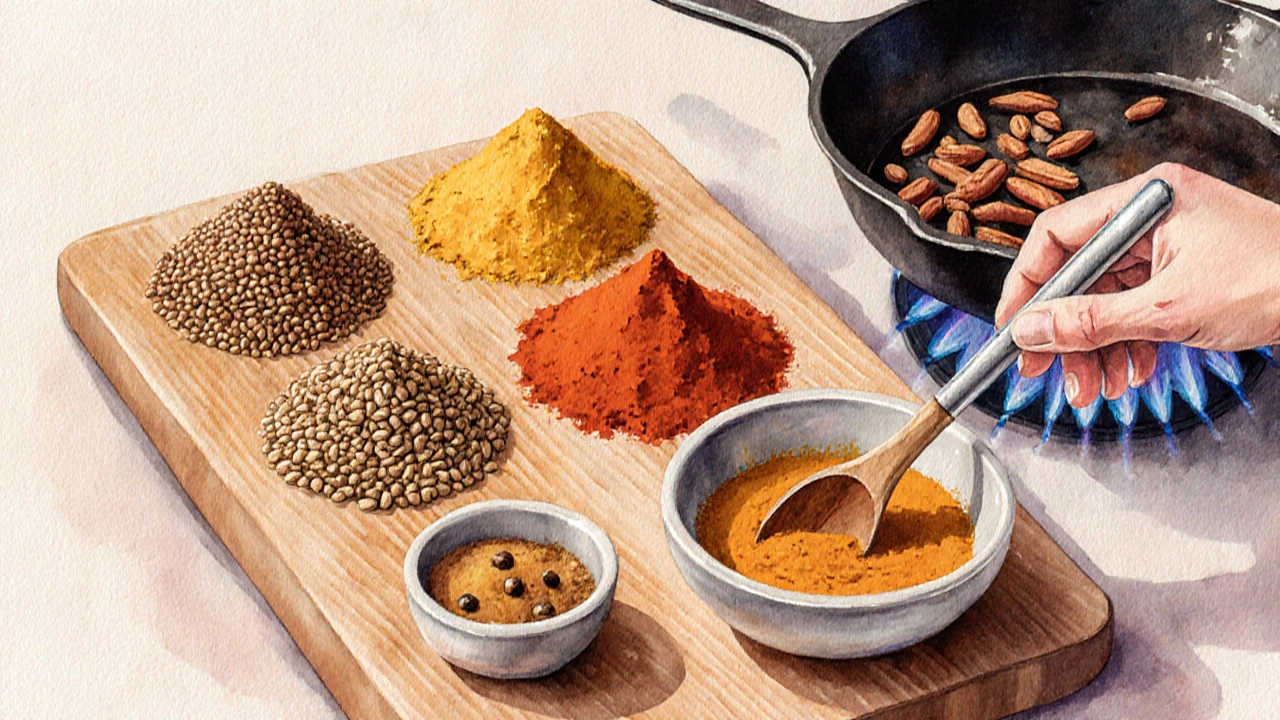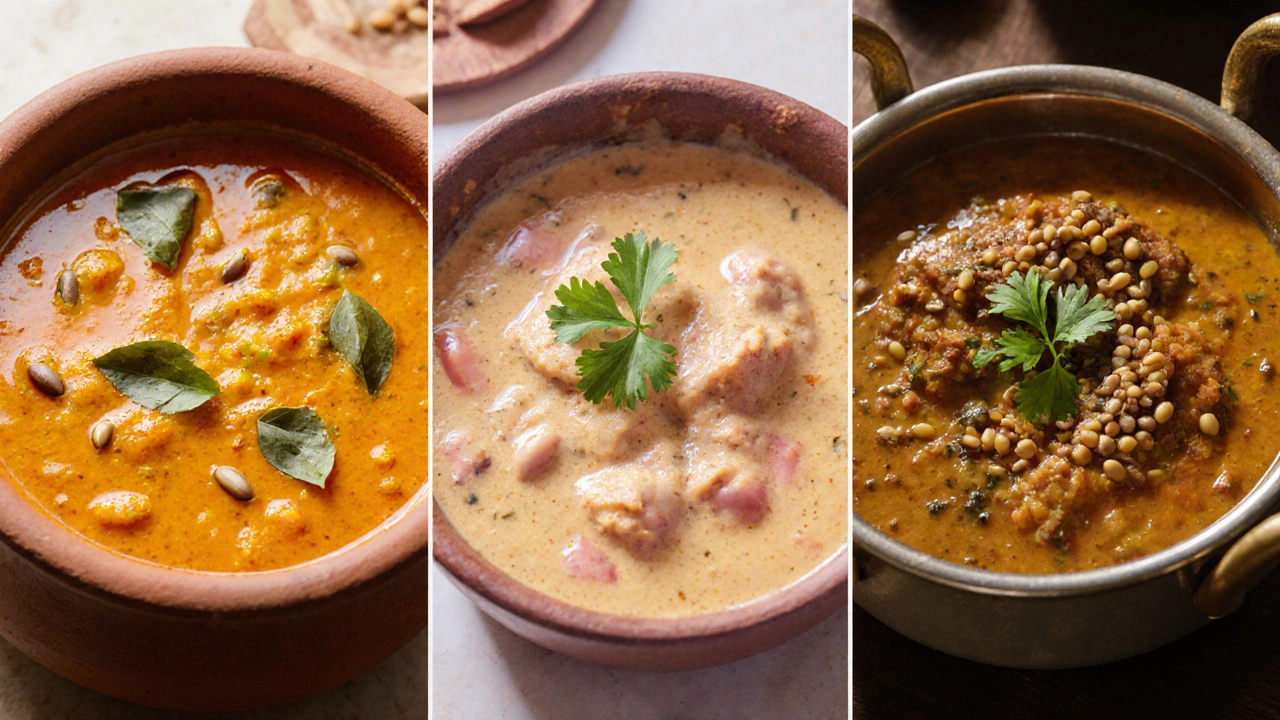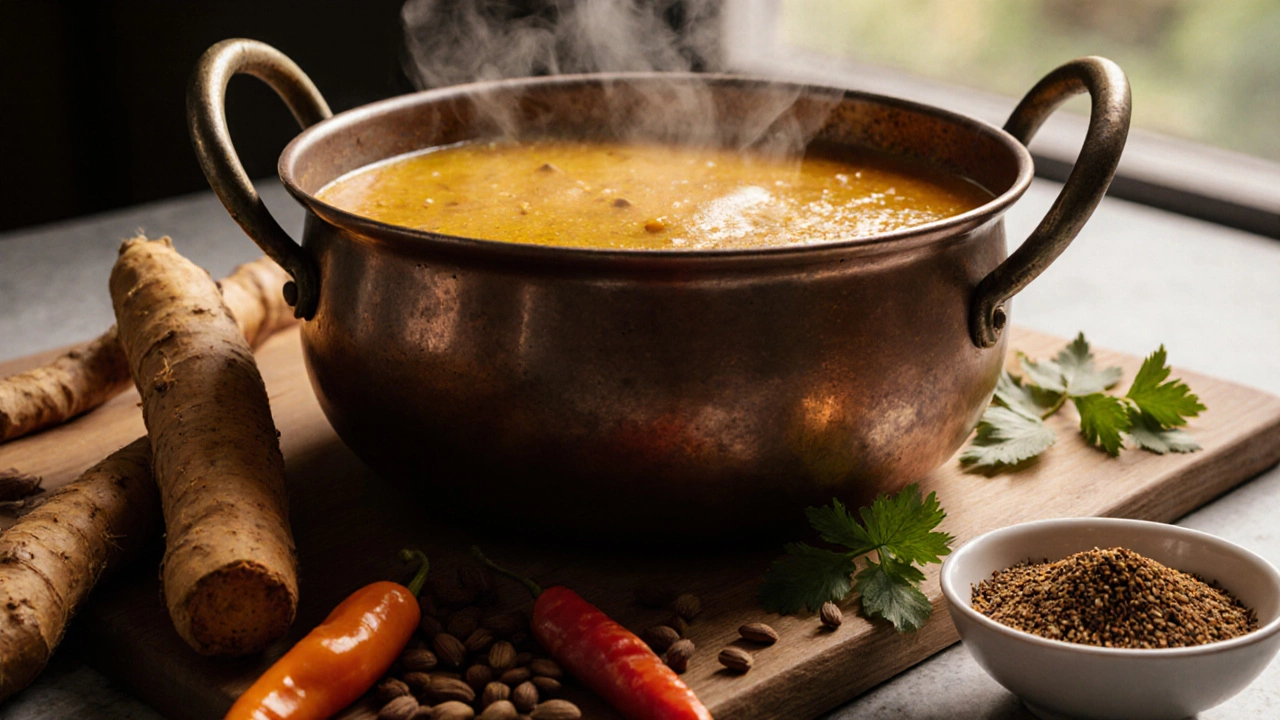10 Oct 2025
- 0 Comments
Turmeric in Curry: Spice Ratio Calculator
Spice Proportions
Turmeric
0.5 - 1 tsp
(5-10%)Cumin
2 parts
(20%)Coriander
2 parts
(20%)Chili
1 part
(15%)Garam Masala
0.5 parts
(5-10%)Recommended Amounts for South Indian Curry
Enter your desired servings and select a curry style to calculate recommended spice amounts.
When you picture a classic Indian curry, the vibrant golden hue is usually the first thing that catches the eye. That color often leads people to assume turmeric is the star spice pulling everything together. But is turmeric really the main player, or does it just dress the dish in a sunny coat while other spices do the heavy lifting?
Key Takeaways
- Turmeric adds color, subtle earthiness, and health‑boosting curcumin, but it’s rarely the dominant flavor in traditional Indian curries.
- Typical curry spice blends balance turmeric with cumin, coriander, chili, and garam masala.
- Regional cuisines in India vary widely - some rely heavily on turmeric, others skip it altogether.
- Understanding proportion and timing helps you use turmeric effectively without overwhelming the dish.
- Quick cheat‑sheet table at the end lets you see the usual spice ratios for common curry styles.
What Exactly Is a Curry?
Curry is a broad term for dishes that combine a sauce or gravy with a blend of spices, herbs, and often vegetables or meat. In Indian cuisine, the word covers a spectrum from thin, broth‑like lentil stews to thick, cream‑laden sauces.
The foundation of any curry is the spice mixture - known locally as masala - which gives each regional style its signature flavor.
Core Spices That Shape a Curry
While turmeric shines in the spotlight, it usually shares the stage with a handful of other spices. Below are the most common contributors, each marked up for easy reference.
Garam masala is a warm, aromatic blend usually added near the end of cooking to boost fragrance.
Cumin is a nutty, slightly peppery seed that forms the earthy backbone of many curries.
Cor iander (ground seeds) is a citrus‑y, sweet spice that balances heat and depth.
Chili powder is a blend of dried chilies that sets the heat level, ranging from mild to fiery.
These four, plus a modest pinch of turmeric, create the classic “basic curry” foundation you’ll find in most home kitchens.

The Role of Turmeric in Curry
Turmeric is a bright‑yellow rhizome prized for its color, mild earthy flavor, and the compound curcumin, which has documented anti‑inflammatory properties.
In a typical curry, turmeric usually accounts for 5‑10% of the total spice weight. Its main contributions are:
- Color: The golden tint signals a “mild” or “saffron‑free” curry to diners.
- Subtle earthiness: It adds a faint, mustard‑like note that rounds out the sharper flavors of cumin and chili.
- Health boost: Curcumin (the active component) may aid digestion and reduce inflammation, though you need a relatively high dose for therapeutic effects.
If you’re looking for the star of the flavor, turmeric steals the show in many golden curries, but it rarely dominates the taste profile.
Regional Variations - When Turmeric Takes Center Stage
India’s culinary landscape is anything but uniform. Here are three broad regions and how they treat turmeric:
- South India: Dishes like sambar and rasam often start with a tempering of mustard seeds, curry leaves, and a generous spoonful of turmeric. The heat comes from dried red chilies, while turmeric provides both color and a gentle warmth.
- North India: Butter‑rich gravies (e.g., butter chicken) rely more on cream, tomato, and garam masala. Turmeric is present but in smaller amounts, serving mostly as a visual cue.
- East Coast (Bengal): Mustard oil and poppy seeds dominate. Some fish curries skip turmeric entirely, letting the mustard oil’s pungency lead.
So, while many classic recipes feature turmeric, there are entire regional cuisines where it’s optional or absent.
Common Misconceptions About Turmeric and Curry
- “Turmeric = curry powder.” Curry powder is a British invention that blends turmeric, coriander, cumin, and other spices into a single pantry item. Authentic Indian curries usually start from whole or freshly ground spices, not pre‑mixed powder.
- “More turmeric = better flavor.” Over‑loading a dish with turmeric can make it taste bitter and overly astringent. Balance is key.
- “Turmeric alone can give health benefits.” Curcumin’s absorption improves when paired with black pepper (piperine) and fats. A plain turmeric‑only curry won’t deliver the same nutritional punch.

Build Your Own Balanced Curry Spice Blend
Want to control the flavor and still keep turmeric’s benefits? Follow these simple steps:
- Measure out your base: 2parts cumin, 2parts coriander, 1part turmeric.
- Add heat: 1part chili powder (adjust to taste).
- Introduce aroma: ½part garam masala (add at the end of cooking).
- Optional boosters: a pinch of fenugreek seeds for sweetness, a dash of black pepper to enhance curcumin absorption.
- Toast the whole spices (cumin, coriander, fenugreek) in a dry pan for 30seconds, then grind. Mix with the pre‑ground powders.
- Store in an airtight jar away from light; the blend stays fresh for up to six months.
This recipe yields a versatile mix that works for vegetable, chicken, or lentil curries without overwhelming any single flavor.
Quick Cheat‑Sheet: Typical Spice Ratios for Common Curry Types
| Spice | South Indian Curry | North Indian Curry | British‑style Curry Powder |
|---|---|---|---|
| Turmeric | 10% | 5% | 15% |
| Cumin | 20% | 15% | 20% |
| Cor iander | 20% | 20% | 20% |
| Chili powder | 15% | 10% | 15% |
| Garam masala | 5% | 10% | 10% |
Adjust the percentages based on personal heat tolerance and the desired color intensity. Remember, the sum of all spices should not exceed 25‑30% of the total dry ingredient weight for a balanced curry.
Frequently Asked Questions
Does turmeric affect the taste of a curry?
Yes, but only subtly. Turmeric contributes a faint earthy‑mustard note and a warm background flavor. The dominant tastes usually come from cumin, coriander, and chili.
Can I skip turmeric if I don’t have it?
Absolutely. You’ll lose the signature golden color and a small health boost, but the curry will still taste great if you boost other spices or add a pinch of saffron for color.
Is turmeric the same as curry powder?
No. Curry powder is a blend that typically contains turmeric, but also cumin, coriander, fenugreek, and sometimes mustard. Turmeric is just one ingredient in that mix.
How much turmeric should I use per serving?
For a dish serving 4 people, about ½-1teaspoon of ground turmeric is typical. That translates to roughly 2‑3grams, enough for color and flavor without bitterness.
Will adding black pepper improve turmeric’s health benefits?
Yes. Piperine in black pepper can increase curcumin absorption by up to 2,000%. A pinch of pepper in your curry makes the health boost more effective.
